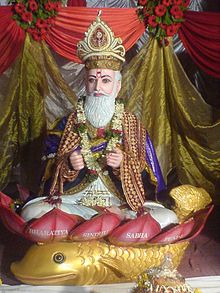Avatar
In the goddess-based Shaktism tradition of Hinduism, avatars of the Devi in different appearances such as Tripura Sundari, Durga, Chandi, Chamunda, Mahakali, and Kali are commonly found.[3] Avatar means 'descent, alight, to make one's appearance',[3] and refers to the embodiment of the essence of a superhuman being or a deity in another form.[3] In Hindu traditions, the "crossing or coming down" is symbolism, states Daniel Bassuk, of the divine descent from "eternity into the temporal realm, from unconditioned to the conditioned, from infinitude to finitude".[5] An avatar, states Justin Edwards Abbott, is a saguna (with form, attributes) embodiment of the nirguna Brahman or Atman (soul).[21] Avatar, according to Bhaktisiddhanta Sarasvati actually means 'divine descent' in his commentaries of The Shrimad Bhagavatam and The Bramha Samhita (mentioned in Brahmavaivarta Purana).[5] The verb roots and form, such as avatarana, appear in ancient post-Vedic Hindu texts, but as "action of descending", but not as an incarnated person (avatara).[22] The related verb avatarana is, states Paul Hacker, used with double meaning, one as action of the divine descending, another as "laying down the burden of man" suffering from the forces of evil.[23] It is in medieval era texts, those composed after the sixth century CE, that the noun version of avatar appears, where it means embodiment of a deity.[20] In some contexts, the term avatara just means a 'landing place, site of sacred pilgrimage', or just 'achieve one's goals after effort', or retranslation of a text in another language.The term avatar in Hinduism refers to act of various gods taking form to perform a particular task which in most of the times is bringing dharma back.[30] An oft-quoted passage from the Bhagavad Gita describes the typical role of an avatar of Vishnu:[9][26] Arjuna, whenever righteousness is on the decline, unrighteousness is in the ascendant, then I body Myself forth.Freda Matchett states that this re-sequencing by the composers may be intentional, so as to avoid implying priority or placing something definitive and limited to the abstract.[29] The Pancharatra text of Vaishnavism declares that Vishnu's avatars include those that are direct and complete (sakshad), indirect and endowed (avesha), cosmic and salvific (vyuha), inner and inspirational (antaryamin), consecrated and in the form of image (archa).[53][54] The Guna-avatar classification of avatars is based on the Guṇas concept of the Samkhya school of Hindu philosophy, that is Rajas (Brahma), Sattva (Vishnu), and Tamas (Shiva).[58] 24 avatars of Vishnu are mentioned in Bachitar Natak's composition in Dasam Granth, the second scripture of Sikhism written by Guru Gobind Singh:[59] The Guru Granth Sahib reverentially includes the names of numerous Hindu deities, including Vishnu avatars such as Krishna, Hari, and Rama, as well those of Devi as Durga.[18][64] The Sikh Gurus endorsed the view of Hindu Bhakti movement saints such as Namdev (≈1270 – 1350 CE) that formless eternal god is within the human heart and man is his own savior.[18][65] The Gupti Ismailis, who observe pious circumspection as Hindus, uphold that the first Shi‘i Imam, ‘Ali b. Abi Talib, as well as his descendants through the line of Isma‘il, are collectively Kalki, the tenth and final avatāra of Vishnu.With this in mind, Lakshmi's forms include: In Dasam Granth, second scriptures of Sikhs written by Guru Gobind Singh, mentioned seven Brahma Avatars.[90] The Mudgala Puranam describes eight avatars of Ganesha:[91] Jhulelal, the Iṣṭa-devatā (most-revered deity) of Sindhi Hindus, is considered the incarnation of Varuna.

Avatar (disambiguation)Indic textquestion marks or boxesHinduismHindusMythologyOriginsHistoryIndus Valley CivilisationVedic HinduismDravidian folk religionŚramaṇaTribal religions in IndiaItihasa-PuranaEpic-Puranic royal genealogiesEpic-Puranic chronologySampradaya (Traditions)VaishnavismPancharatraShaivismKapalikaPashupataPratyabhijñaShaktismSmartismOther Sampradaya (Traditions)DeitiesAbsolute Reality / Unifying ForceBrahmanTrimurtiBrahmaVishnuTrideviSaraswatiLakshmiParvatiTridashaAdityasRudrasAshvinsMahadeviOther Vedic DeitiesDashavataraNavadurgaMahavidyaKartikeyaGaneshaHanumanShaktiDevatasVishvakarmaKuberaConceptsCosmologyTattvasSubtle elementsPanchikaranaGross elementsGuṇasPurushaPrakṛtiSupreme realityNirgunaSagunaSaccidānandaIshvaraGod in HinduismGod and genderPuruṣārtha (Meaning of life)DharmaMokshaĀśrama (Stages of life)BrahmacharyaGṛhasthaVānaprasthaSannyasaThree paths to liberationBhakti yogaJnana yogaKarma yogaLiberationParamātmanSaṃsāraĀtman (self)Anātman (non-self)Sūkṣma śarīra (subtle body)Antaḥkaraṇa (mental organs)Prajña (wisdom)Ānanda (happiness)Viveka (discernment)Vairagya (dispassion)Sama (equanimity)Uparati (self-settledness)Titiksha (forbearance)Shraddha (faith)Samadhana (concentration)Arishadvargas (six enemies)Ahamkara (attachment)NiyamaAhimsaAchouryaAparigrahaAkrodhaArjavaSantoshaSvādhyāyaShauchaMitaharaSources of dharmaEpistemologyPratyakṣa (perception)Upamāṇa (comparison, analogy)Śabda (word, testimony)WorshipĀrtīPrarthanaŚrautaTempleBhaktiBhajanaKīrtanaTarpanaPrāyaścittaTirthaTirthadanaNritta-Nritya

